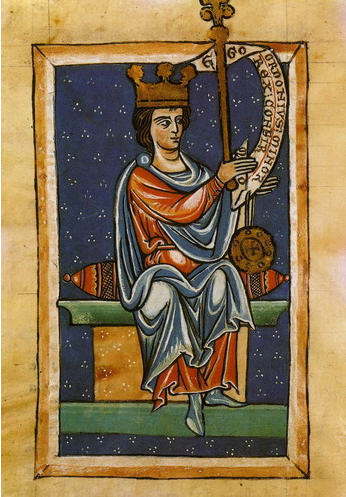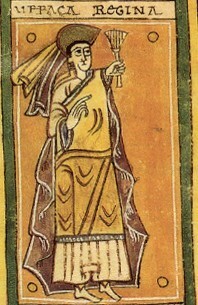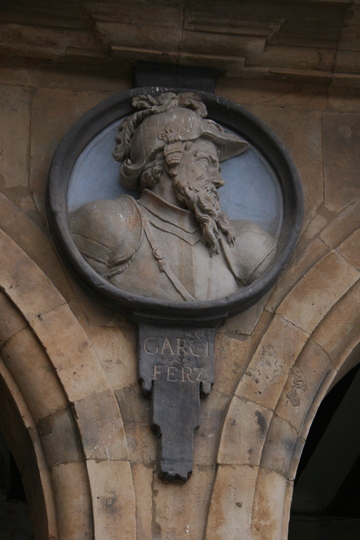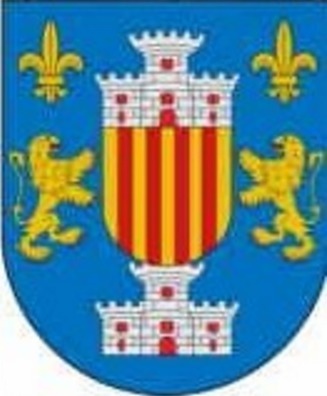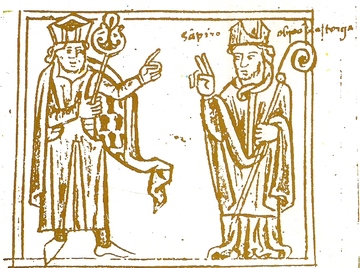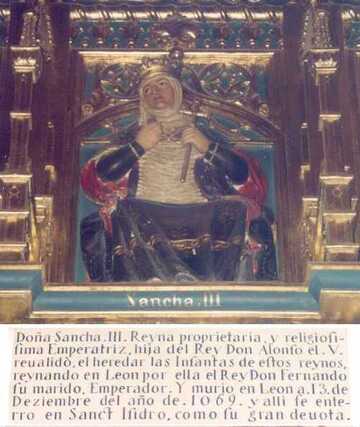maximum test » Alfonso V 'el Noble' de León Rey de León (996-1028)
Persoonlijke gegevens Alfonso V 'el Noble' de León Rey de León
- Hij is geboren in het jaar 996.
- Beroep: Roi, de Léon.
- Hij is overleden op 4 juli 1028, hij was toen 32 jaar oudViseu Portugal.
- Hij is begraven in St. Isidore de León, León, Spain.
- Een kind van Bermudo II 'el Gotoso' de León en Elvira García de Castilla
- Deze gegevens zijn voor het laatst bijgewerkt op 22 januari 2019.
Gezin van Alfonso V 'el Noble' de León Rey de León
![]() Let op: Echtgenote (Urraca García de Navarra) is ook zijn nicht.
Let op: Echtgenote (Urraca García de Navarra) is ook zijn nicht.
(1) Hij heeft/had een relatie met Elvira Mendes.
Kind(eren):
(2) Hij had een relatie met Urraca García de Navarra.
Kind(eren):
Notities over Alfonso V 'el Noble' de León Rey de León
Name Prefix:King Name Suffix: V, Of Leon "El Noble"
Alfonso ?den Ærlige? var konge av Leon 999 - 1027.
Alfonso ble 5 år gammel konge av Leon i 999 og regjerte først under formynderskap av
sin mor, doña Elvira, greve Menendo Gonzales av Galicien, greve Sancho Garcias av Castilla
og kong Sancho Garcias Cuatromanos (den Store) av Navarra.
I 1002 førte hun (hans mor?) et brilliant felttog i Portugal som særlig utmerket seg i
slaget ved Calatañazor.
Alfonso reparerte Leon etter de ødeleggelser maurerne under ledelse av Almanzor
hadde forårsaket, og innrettet kirken St. Jean som gravsted for kongene av Leon. I 1017 kom
han i strid med sin onkel, greven av Castilla, da han mottok familien Véla som var blitt jaget
bort fra Castilla. I 1020 samlet han rikets Cortés i Leon og publiserte ?El Fuero de Leon?
(Leons lovforsamling) i 58 paragrafer eller dekreter. Han var den første som anvendte titelen
konge av Castilla.
Alfonso ble drept ved beleiringen av Viscu.
It fell to ALPHONSO V (999-1027) to begin the work of reorganizing the Christian kingdom of the northwest after a most disastrous period of civil war and Arab inroads. Enough is known of him to justify the belief that he had some of the qualities of a soldier and a statesman. His name, and that of his wife Geloria (Elvira), are associated with the grant of the first franchises of Leon. He was killed while besieging the town of Viseu in northern Portugal, then held by the Mohammedans.
It fell to ALPHONSO V (999-1027) to begin the work of reorganizing the Christian kingdom of the northwest after a most disastrous period of civil war and Arab inroads. Enough is known of him to justify the belief that he had some of the qualities of a soldier and a statesman. His name, and that of his wife Geloria (Elvira), are associated with the grant of the first franchises of Leon. He was killed while besieging the town of Viseu in northern Portugal, then held by the Mohammedans.
It fell to ALPHONSO V (999-1027) to begin the work of reorganizing the Christian kingdom of the northwest after a most disastrous period of civil war and Arab inroads. Enough is known of him to justify the belief that he had some of the qualities of a soldier and a statesman. His name, and that of his wife Geloria (Elvira), are associated with the grant of the first franchises of Leon. He was killed while besieging the town of Viseu in northern Portugal, then held by the Mohammedans.
The son of Bermudo II, He was able to recapture the lost Leonese territory in
the years following the death of al-Mansur of cordoba.
The son of Bermudo II, He was able to recapture the lost Leonese territory in
the years following the death of al-Mansur of cordoba.
The son of Bermudo II, He was able to recapture the lost Leonese territory in
the years following the death of al-Mansur of cordoba.
The son of Bermudo II, He was able to recapture the lost Leonese territory in
the years following the death of al-Mansur of cordoba.
It fell to ALPHONSO V (999-1027) to begin the work of reorganizing the Christian kingdom of the northwest after a most disastrous period of civil war and Arab inroads. Enough is known of him to justify the belief that he had some of the qualities of a soldier and a statesman. His name, and that of his wife Geloria (Elvira), are associated with the grant of the first franchises of Leon. He was killed while besieging the town of Viseu in northern Portugal, then held by the Mohammedans. [Encyclopaedia Britannica, 1961 ed., Vol. 1, p. 687,
{geni:about_me} https://es.wikipedia.org/wiki/Alfonso_V_de_Le%C3%B3n
http://genealogics.org/getperson.php?personID=I00120381&tree=LEO
Alfonso V, hereda el trono a la edad de cinco años, tras la muerte de su padre Bermudo II. Dada su minoría de edad, su madre, Elvira García, (hija del conde de Castilla), y el conde gallego Menendo González, actuarán de regentes.
Sus primeros años, coinciden con los últimos de Almanzor, continuando las incursiones musulmanas, sufriendo, los cristianos la gran derrota de Cervera. Pero la muerte de éste en 1002, dará paso a un período de tranquilidad, primero, debido a las pugnas en Al-Andalus por la sucesión, que recayó en el hijo de Almanzor, desatándose de nuevo a la muerte de éste en 1008, subiendo al trono su hermano, Abderramán “Sanchuelo” con el patrocinio de los nobles cristianos.
Conseguida cierta paz con los musulmanes, y nombrado mayor de edad, Alfonso V, trató de controlar el reino, afianzando su poder. En 1017, otorgará los llamados “fueros de León”, que sancionaban jurídicamente el feudalismo leonés, tras una reunión con los nobles que forman la Curia. Ante ella tratará también de afirmar el poder regio sobre el de los nobles.
Esta consolidación de su poder, le permitió retomar la política de expansión y consolidación que sus predecesores en el cargo habían puesto en marcha hace muchos años, y que se había visto paralizada durante los últimos reinados. No sólo repuebla, sino que también va a intentar conquistar nuevos territorios en la Lusitania. En 1028, pone cerco a la ciudad de Viseu, pero en un reconocimiento del recinto amurallado, será asesinado por una flecha lanzada por el enemigo desde las murallas. El elevado calor, hizo al rey machar sin protección alguna, lo que posibilitó su muerte.
Durante su reinado repelió también nuevas incursiones de los normandos, y logró poner fin a las disputas con los Navarros por los territorios limítrofes entre ambos reinos, al casarse con Urraca, hermana del entonces rey navarro, Sancho Garcés III.
A su muerte le sucedió su hijo, Bermudo III.
--------------------
Alfonso V de León, el Noble (c. 994 – Viseu, 1028). Rey de León desde 999 hasta su muerte. Sucedió a su padre Bermudo II a la edad de cinco años, quedando bajo la tutela de doña Elvira García, su madre, y del conde gallego Menendo González.
Reconstruyó la ciudad de León, que había sido dañada por los ataques de Almanzor y reunió a los nobles en Curia Plena para la elaboración y posterior aprobación del Fuero de León en 1017.
Alfonso V llega a la mayoría de edad en el año 1017, heredando un reino lleno de inestabilidad política. Su madre Elvira García, hasta entonces regente, y los tres nobles más importantes del reino desaparecieron del mapa en ese mismo año: el conde de Castilla, el jefe de los Banu Gómez y el conde gallego Menendo Rodríguez, que habían sido fuente de problemas en la regencia anterior. Alfonso V quiere dar un giro a la administración, y para eso necesita primero un nuevo marco jurídico.
Así, en 1017, en una reunión de la Curia Regia, se promulga el Fuero de León, que se ha calificado como la sanción jurídica del feudalismo leonés. Con ella se buscaba poner fin a los desórdenes de la etapa anterior y recuperar el poder real.
Reciben el nombre de «Fuero de León» un conjunto de preceptos decretados por el rey de León Alfonso V en un concilium reunido en la catedral de León en el año 1020. A estos 20 preceptos se les añadieron otros 28 que regulaban la vida local en la ciudad de León.
Casó por primera vez en el año 1013 con Elvira Menéndez, fallecida el 2 de diciembre de 1022. Hija del conde gallego Menendo González y su esposa Muniadona, siendo sus abuelos paternos el conde Gonzalo Menéndez «Dux Magnus de Portugal» y la condesa Ilduara Peláez. Nacieron dos hijos de este matrimonio:
Bermudo III de León (1017-1037), rey de León desde el año 1028 al 1037.
Sancha de León (1016-1067), esposa del rey Fernando I de León, el Magno, hijo de Sancho Garcés III de Pamplona.
Contrajo un segundo matrimonio en el año 1023 con Urraca, hija del rey García Sánchez II de Pamplona el Temblón. De este segundo matrimonio nació:
Jimena Alfonso, quien antiguos autores dicen que contrajo matrimonio con el conde Fernando Gundemáriz, aunque historiadores modernos sostienen que la esposa del conde Fernando Gundemáriz fue Sancha Ordóñez.
Falleció sitiando la plaza de Viseu, en Portugal en 1028. Su cadáver fue llevado a la ciudad de León y sepultado en el Panteón de Reyes de San Isidoro de León, en compañía de sus padres. El sepulcro de piedra en el que fue depositado el cadáver del rey se conserva en la actualidad, y en su cubierta aparece esculpida la siguiente inscripción latina:
H. IACET ADEFONSUS QUI POPVLATIT LEGIONEM...ET DEDIT BONOS FOROS ET FECIT/ECCLESIAM HANC LVTO ET LATERE. HABVIT PRAELIA CUM/SARRACENIS, ET INTERFECTUS,EST SAGITTA APUD VISEUM/PORTUGAL FUIT FILIUS VEREMUNDI ORDONII/OBIIT ERA M SEXAGESIMA QUINTA III NAS M.
www.wikipedia.com
--------------------
Birth: unknown, Spain
Death: Aug. 7, 1028
Viseu
Viseu Municipality
Viseu, Portugal
Alfonso was the son of Bermudo II, King of Leon and Elvira Garcia, born about 995.
His first wife was Elvira Melendez, the daughter of his tutor Menendo González at whose house he was raised as a child. They had two children:
* Bermudo III
* Sancha who would marry Fernando I, King of Castile
Elvira died in 1022 and Alfonso became the husband of Urraca, the daughter of Garcia Sanchez II. The King of Pamploma would protest the marriage on the basis of incest, but the marriage took place in 1023. They had one daughter, Jimena Leon.
Alfonso was the King of Leon 999 to 1028, and Alfonso V "the Noble", Emperor of Spain.
His father died when he was a young child of four or five, his mother acted as regent until she retired to a nunnery in 1007.
He was killed by an arrow while besieging the town of Viseu in northern Portugal, then held by the Muslims. According to his wishes, King Alfonso was buried next to his first wife at the Church of Saint John the Baptist and San Pelayo which became the Basilica of San Isidoro when the latter saint's remains were transferred from Seville.
Family links:
Parents:
Bermudo II De Leon
Spouse:
Elvira Mendes DeLeon (____ - 1022)*
Children:
Sancha de León (1013 - 1067)*
Bermudo De Leon (1017 - 1037)*
*Calculated relationship
Inscription:
H. IACET ADEFONSUS QUI POPVLATIT LEGIONEM...
Here lies Adefonsus who populated this legion
ET DEDIT BONOS FOROS ET FECIT
He did and gave a good bargain
ECCLESIAM HANC LVTO ET LATERE.
(This church of clay and brick)
HABVIT PRAELIA CUM
I battle with
SARRACENIS, ET INTERFECTUS,
Saracens, and was killed,
EST SAGITTA APUD VISEUM
With an arrow's visit
PORTUGAL FUIT FILIUS VEREMUNDI ORDONII
Portugal's son Veremundus Ordonie
OBIIT ERA M SEXAGESIMA QUINTA III NAS M
Obit era 1000 followed by unknown
Burial:
Basilica Of San Isidoro
León
Provincia de León
Castilla y León, Spain
Created by: Anne Shurtleff Stevens
Record added: Apr 11, 2012
Find A Grave Memorial# 88346169
Rey de León (999-1028)
Rey de León (999-1028)
RESEARCH NOTES:
King of Leon (999-1028)
SOURCE NOTES:
www.dcs.hull.ac.uk/cgi-bin/gedlkup/n=royal?royal10133
King of Leon and Galicia from the year 999 to his death in 1028.
Succeeded his father, Bermudo II at the age of five under the Regency of his mother, Elvira.
During his minority years Navarra and Castile were taken in the battle of Calatanazor. He repopulated the city of Leon that had been destroyed by the Moors.
852677962. Alfons V BERMUDOSON (19160) was born in 994.(19161) He was a Konge in 999 in Leon.(19162) Han ble 5 år gammel konge av Leon, og regjerte først under formynderskap av sin mor dona Elvira, og grev Menendo Gonzales av Galicien, grev Sancho Garcias av Kastiljen og kong Sancho Garcias den Store eller Cuatromanos av Navarra. He died on 5 May 1027.(19163) Han ble drept ved beleiringen av Viscu I 1002 førte hans mor (formynder) et brilliant felttog i Portugas som særlig utmerket seg ved slaget ved Calatanazor.
Alfons reparerte Leon etter dets ødeleggelser av arabern Almanzor og innterret kirken i St. Jean som gravsted for kongene i Leon. 1017 kon han i strid med sin onkel, greven av Kastiljen, og oppptok sitt land familien Vela som var blitt jaget bort fra Kastiljen. I 1020 samlet han rikets Cortes i Leon og publicerte el Fuero de Leon (Leons lovforsamling) i 58 paragrafer eller dekreter. han var den første som anvendte titelen konge av Kastiljen. He was married to Dronning Elvira MENDOSON av Leon in 1008/9
ALFONSO V DE LEON
http://trees.ancestry.com/rd?f=document&guid=d5105e0e-dbe1-456f-a8c2-27b40c606995&tid=10145763&pid=-312333908
ALFONSO V DE LEON
http://trees.ancestry.com/rd?f=document&guid=d5105e0e-dbe1-456f-a8c2-27b40c606995&tid=10145763&pid=-312333908
He ruled from 994 to 1027. He attempted to spread Christianity throughout his kingdom and died while besieging the Moors in Northern Portugal.
Alfonso V (994-1028), called the Noble, King of León, son of Bermudo II by his second wife Elvira García of Castile, reigned from 999 to 1028. The Abbot Oliva called him Emperor of all Hispania.
Because of his youth at his father's death, his mother acted as a regent. She retired in 1007 and became a nun. He began the work of reorganizing the Christian kingdom of the northwest of the Iberian Peninsula after a most disastrous period of civil war and Arab inroads. Enough is known of him to justify the belief that he had some of the qualities of a soldier and a statesman.
His name, and that of his wife Elvira Mendes (sometimes Geloria Mendes), are associated with the grant of the first franchises of León (1017). He was killed by an arrow while besieging the town of Viseu in northern Portugal, then held by the Muslims.
Family
His first wife was Elvira Mendes
Alfonso and Elvira had two children:
Bermudo III (c. 1015-1037)
Sancha of León (c. 1020-1067), married Ferdinand I of León
His second wife was Urraca of Navarre, daughter of García Sánchez II of Pamplona
Alfonso and Urraca had one daughter:
Jimena of León, married Fernando Gundemariz
See also
Kingdom of León
Leonese language
References
This article incorporates text from the Encyclopædia Britannica, Eleventh Edition, a publication now in the public domain.
Tijdbalk Alfonso V 'el Noble' de León Rey de León
Deze functionaliteit is alleen beschikbaar voor browsers met Javascript ondersteuning.
Klik op de namen voor meer informatie.
Gebruikte symbolen:  grootouders
grootouders
 ouders
ouders
 broers/zussen
broers/zussen
 kinderen
kinderen
 grootouders
grootouders
 ouders
ouders
 broers/zussen
broers/zussen
 kinderen
kinderen
Voorouders (en nakomelingen) van Alfonso V 'el Noble' de León
Alfonso V 'el Noble' de León 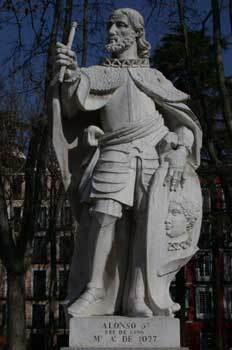 | ||||||||||||||||||||||||||||||||||
(1) | ||||||||||||||||||||||||||||||||||
Elvira Mendes | ||||||||||||||||||||||||||||||||||
(2) | ||||||||||||||||||||||||||||||||||
Urraca García de Navarra | ||||||||||||||||||||||||||||||||||
De getoonde gegevens hebben geen bronnen.
Aanknopingspunten in andere publicaties
Deze persoon komt ook voor in de publicatie:Dezelfde geboorte/sterftedag
- 1187 » Reinoud van Châtillon (~62), heer van Chatillon
- 1623 » William Byrd (~80), Brits componist
- 1761 » Samuel Richardson (71), Brits auteur
- 673 » Egbert I van Kent (~23), Angelsaksisch koning
- 965 » Benedictus V (?), tegenpaus (in 964)
- 973 » Ulrich van Augsburg (~83), bisschop van Augsburg
Over de familienaam De León
- Bekijk de informatie die Genealogie Online heeft over de familienaam De León.
- Bekijk de informatie die Open Archieven heeft over De León.
- Bekijk in het Wie (onder)zoekt wie? register wie de familienaam De León (onder)zoekt.
De publicatie maximum test is opgesteld door Ard van Bergen.
Wilt u bij het overnemen van gegevens uit deze stamboom alstublieft een verwijzing naar de herkomst opnemen:
Ard van Bergen, "maximum test", database, Genealogie Online (https://www.genealogieonline.nl/maximum-test/I4876709487680081308.php : benaderd 30 april 2025), "Alfonso V 'el Noble' de León Rey de León (996-1028)".
Ard van Bergen, "maximum test", database, Genealogie Online (https://www.genealogieonline.nl/maximum-test/I4876709487680081308.php : benaderd 30 april 2025), "Alfonso V 'el Noble' de León Rey de León (996-1028)".
